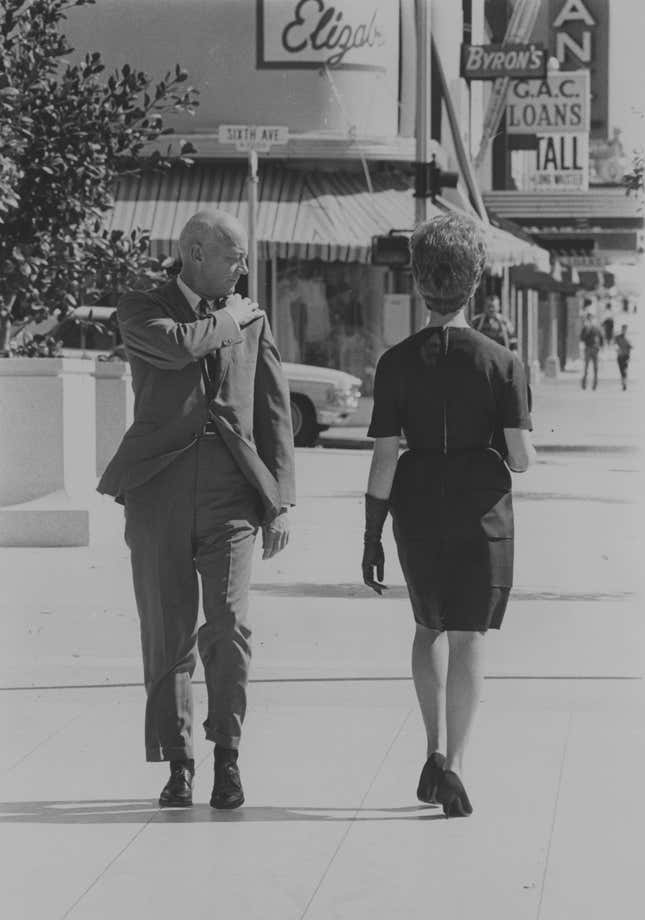
Graphic: Elena Scotti (Photos: Getty Images)
In the spring of 1968, 21-year-old Francine Gottfried began working as an IBM machine operator at a data processing plant in lower Manhattan. Gottfried walked past the New York Stock Exchange to get from the subway to work each day, and she soon attracted a group of Wall Street workers who gaped at her large breasts and verbally harassed her. Over the following months, men circulated the details of her daily schedule—she typically emerged from the Broad Street subway at 1:28 pm for her afternoon shift—and the crowd grew.
By September, Gottfried’s body and the men’s aggressive behavior had become national news: “Boom and Bust on Wall Street,” read one New York Magazine article. According to the Associated Press, the group of men stalkers reached more than 5,000 on a single day; another news outlet claimed the group hit a record of 10,000. Police became concerned about the rowdy crowds of men who clogged traffic and crumpled car roofs as they clambered for a better view of Gottfried’s breasts. Soon, Gottfried required a police escort and had to take new routes to work to avoid the street harassment.
But if Gottfried’s treatment seems horrific, she was just one of many women subjected to “girl watching,” a two-decade trend popularized by an ad executive and broadcast through major ad campaigns. Girl watching guides and girl watching clubs of the midcentury (alongside cartoons and advertisements) taught American men how to sexualize and harass women on the street, among other public places. These activities even had a soundtrack: At the very moment Gottfried was being harassed on Wall Street, the song “Girl Watcher” by the American pop band The O’Kaysions was climbing the charts. The history of this girl watching phenomenon speaks volumes about how the “male gaze” was made and then resisted.
In 1954, New York advertising executive Donald Sauers published a tongue-in-cheek book for “respectable” white men who liked to ogle women. Standing around and watching women had long been widespread, but earlier in the 20th century, middle and upper-class people considered the practice disreputable. A number of cities even tried to crack down on the “optical peccadillos” of men. In the 1920s in Montgomery, Alabama, the police chief announced that he would charge or arrest young men who stood on street corners ogling women and commenting on their appearances. A Baltimore police magistrate initiated a similar crackdown for men who cruised in cars and stared at women. And in Los Angeles in the 1930s, a city councilor introduced a bill that made it a crime for “two or more men, or boys 14 years of age or over, to ogle women in public spaces.” These authorities upheld the idea that girl watching was a low-class and unsavory practice.
Sauers, however, flipped the script. He claimed girl watching as a mainstream, middle-class activity, redefining it as a hobby that men should pursue with gusto. Loosely modeled on bird watching guides, The Girl Watcher’s Guide advised men on the best places to spot girls; it categorized women into different types, such as the “brown-backed beachbomb,” the “pubthrush” and the “fortyplus,” and it provided tips and tactics, especially for married men, on how to watch women discreetly. To promote the book, Sauers founded a girl watching club, the American Society of Girl Watchers, whose members received lapel pins and guidebooks. Tens of thousands of men joined Sauers’ group and similar clubs, and they purchased girl-watching books and magazines. Meanwhile, official girl watching weeks became popular across the United States and Canada.

The girl watching phenomenon gained steam in the 1950s at a moment when men openly embraced “picking up” women for casual sex before marriage. And a burgeoning erotica market, spearheaded by magazines like Playboy, Glamour Photography, and High Magazine appealed to the sexual fantasies of married men. The latter, High Magazine, surrounded features like “The Emasculation of the Suburban Male” and “Time Off For Husbands”—which advocated for vacations away from wives—with pictures of scantily clad women. Sauers’s girl watching guide, which taught married men how to discreetly look at women who weren’t their wives, hit the markets a year after the first issue of Playboy, which similarly advocated the casual sexual objectification of women. These publications all converged on the idea that married men’s gazes and fantasies extended well beyond the marriage bed.
Meanwhile, women who sought sexual intimacy outside of marriage or steady relationships were commonly called “sluts” or “pigs.” Non-lurid representations of unmarried women’s sexual desires were rare. There were notable exceptions including writer Helen Gurley Brown’s 1962 best-seller Sex and the Single Girl, in which she argued that women too should be able to experience sex for pleasure (and material gain) before marrying. But such claims took place within a culture that emphatically stated that sexuality was the prerogative of men. Within these contexts, the girl watching craze fostered the idea that even a passing encounter between a man and a woman in public offered men infinite visual pleasures and even sexual possibilities.
-

-

-

-

-

-

-

-

-

-

-

-

-

-

-

-

-

-

-

-

-

-

-

-

-

-

-

-

-

-

-

-

-

-

-

-

-

-

-

-










































